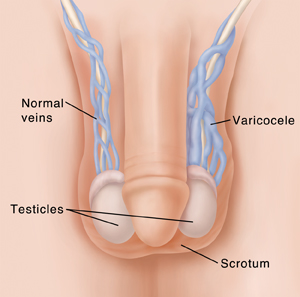Varicocele
A varicocele is a swelling in the veins above the testicles. These veins are found along the cord that holds up a man's testicles (spermatic cord). It's similar to a varicose vein in the legs. The swelling happens when too much blood collects in the veins. It most often occurs around the left testicle. A varicocele may cause the sac of skin covering the testicles (the scrotum) to have a bluish color. It may also cause an achy or heavy feeling in the scrotum. The pain may be worse later in the day or after you've been standing for a long time. Some varicoceles can be seen all the time. Others can be seen only when you're standing. Or they may be seen only when a Valsalva maneuver is done. This means bearing down in your belly (abdomen) to increase pressure.
In most cases, a varicocele isn't serious. It doesn't need to be treated. But it's linked to being unable to have a child (infertility). If you and your partner are trying to have a baby, talk with your health care provider about your choices.

What causes a varicocele?
Veins contain valves that prevent blood from flowing backward. Varicocele develops when there is a problem in these valves, causing blood to leak backward and pool in the veins. This leads to swelling of the veins.
A kidney tumor is the most common cause of a sudden appearance of a varicocele in an older age group. This is because the tumor can block blood flow to the veins. This results in a varicocele.
Who is at risk?
-
Varicoceles are more common in men ages 15 to 25 years. About 15% to 20% of all adult males will have a varicocele. Up to 40% of men evaluated for infertility will also have one.
-
Tobacco smokers.
-
People with other conditions like deep vein thrombosis or blood clots.
What are the symptoms of a varicocele?
Varicoceles don't usually have symptoms, but 2% to 10% of people with varicoceles will complain of pain. Other symptoms may include:
-
Swelling in the scrotum.
-
Dull ache or discomfort.
-
Enlarged, twisted veins in the scrotum, often described as looking like a bag of worms.
-
Possible problems with fertility or decreased sperm count.
How is a varicocele diagnosed?
Your provider will do a physical exam. The provider looks for soft lumps above the testicle, usually on the left side of the scrotum. Other tools for a diagnosis include:
-
Doppler ultrasound. An ultrasound can show a widening of the veins.
-
Thermal imaging. This painless, noncontact method checks for changes in temperature around the affected area.
-
Ultrasound of the kidneys. This can help rule out other causes of varicocele like a kidney tumor.
How is a varicocele treated?
If you have no symptoms and no fertility problems, you might not need any treatment.
No medicines are available to fix this condition. Surgery can be done to close off the enlarged veins. A varicocele is not serious. And all surgery has risks. So you and your provider may consider surgery only if:
-
The pain becomes worse or you have new symptoms.
-
The testicle shrinks (atrophy).
-
You want to try to improve your fertility.
There are 2 main types of surgery to correct a varicocele:
-
Varicocelectomy. The urologist (surgeon) makes an incision (cut), most often in the lower abdomen, and ties off the abnormal veins. This directs blood flow in the area to the normal veins. The operation may also be done as a laparoscopic procedure (through small incisions with a camera).
-
Varicocele embolization. This is done by a radiologist. It uses tiny metal coils to block the veins that are causing the problem. This is done under local anaesthetic and sedation. Recovery is usually quick.
Home care
Use an ice pack on the area for the first 24 hours after surgery to reduce swelling. Put a thin cloth between the ice and your skin.
To help reduce discomfort, aching, or pain:
Follow-up care
Follow up with your provider as advised. Schedule regular exams with your provider so the varicocele can be watched. Keep all your appointments. Tell your provider if you see any changes in your testicles or scrotum.
When to contact your doctor
Contact your provider right away if:
-
You feel more pain in your scrotum.
-
You have trouble peeing.
-
You notice a lump in the testicle.
-
A bulge in the groin area appears or gets bigger.